Ljubljana related
STA, 29 May 2019 - Several local civil initiatives demand legislative changes and an immediate cull of bears and wolves in areas where livestock is being attacked, in what is an escalation of long-simmering tensions over how to deal with Slovenia's growing population of large carnivores.
In a letter addressed to Prime Minister Marjan Šarec earlier this week, three civil initiatives demand that hunters immediately shoot the number of bears and wolves designate for culling by the Forest Service.
They also want jackal, whose numbers have been growing rapidly in recent years, to be designated as game animal.
Related: Hunting an Ageing Pursuit in Slovenia, and Killing a Bear Costs Between €600 and 6,500 (Feature)
The appeal is the latest instalment of a long dispute that has pitted environmentalists against farmers, scientists and hunters in a fight over what to do with large game in Slovenia.
The bear and wolf population is kept in check with an annual cull and this year the Forest Service proposed that 200 bears be shot, a decision based on scientific estimates of the bear population. Wolves are not slated for culling this year.
But environmentalists challenged the subsequent government decree at the Administrative Court, which refrained from deciding on the cull as such but ordered the government to adopt a new decree setting the number of animals slated for culling.
In the meantime, farmers are reporting increasing damage by bears and wolves and have recently staged a protest in Ljubljana bringing cadavers of animals killed by bears.
The civil initiatives from Kočevje, Notranjska and Primorska, areas in western Slovenia that are home to Slovenia's bear population, now demand that the government also change the law to give expert institutions including the Forest Service, Hunting Association and Chamber of Agriculture and Forestry exclusive say over culling.
Related: In Search of Brown Bears in Slovenia
"The decision-making procedure must be exempt from the legal frameworks of the administrative procedure law and preclude the option of appeal from anyone," the associations said.
Locals would have majority say in any culling decisions and no projects involving large carnivores or other game would be possible without local approval.
Another major demand is to bring the population levels of large carnivores, deer and wild boar to 1990 levels to reduce damage to forests and farmland.
Slovenia is considered by many as a role model for management of large carnivores, but its linchpin has been the regular culling of a very healthy and growing population.
From near extinction in the early 20th century, the population rose to an estimated 700 animals by 2015, according to data by the Biotechnical Faculty.
Scientists have warned that acceptance by locals is key to management as well, with Klemen Jerina, one of the most prominent bear researchers in Slovenia, recently saying that they support the cull of 200 animals.
"But we've come to a point where we believe there are enough bears. If the number continues to grow, the number of conflicts will increase as well," he said in February.
Environmentalists, on the other hand, base their opposition to the cull on the animals' inherent right to live.
STA, 26 April 2019 - The Farmers' Trade Union staged a protest on Friday, demanding that the government take immediate action, as a growing bear population is causing considerable damage to herds. Agriculture Ministry State Secretary Marko Maver promised farmers that an extraordinary kill measure would be ordered to mitigate the situation.
The protest was staged ten days after the Administrative Court sided with an environmental NGO that challenged the ministry's order to kill 200 bears this year.
The bear population is estimated at 750 in Slovenia, while in the early 1990s it was at 350. Currently, the population expands by 200 bears a year and could reach nearly 1,000 by the end of the year unless 200 are killed or relocated.
Unionist Roman Žveglič said that the ministry staff had listened carefully and promised to launch the measure of extraordinary killing in places where bears were causing the most damage.
Maver told the press that the ministry understood the distress of farmers. "We are all aware of the importance of sustainable management of bear population."
The ministry will moreover appeal the Administrative Court's decision and is drafting "additional documents on why the proposed number is justified," said Maver.
Žveglič said that in case the ministry failed to provide assistance, farmers would stage civil disobedience. "This means that we will start hunting wild animals ourselves, poisoning and shooting them."
At the rally, staged in front of the ministry, Florjan Peternel, a farmer from Ilirska Bistrica (SW), brought with him the remains of calves attacked by bears.
Until recently, his herd had no calves due to bear attacks in 2017 and 2018. "A fortnight ago, calvings started and 15 cows had calves. But yesterday, disaster struck. None survived."
All our stories about bears in Slovenia can be found here
A leisurely walk in the woods in many countries, especially in my home country of England, invokes an image not only of peace and tranquillity, but also one of relative ease and safety. One of the advantages of the UK is that nothing really dangerous lurks in our woods; other than the odd crazy person with an axe or a gun. In Slovenia however, while you are less likely to encounter an axe-wielding homicidal maniac, there are other more natural dangers to be aware of: bears!
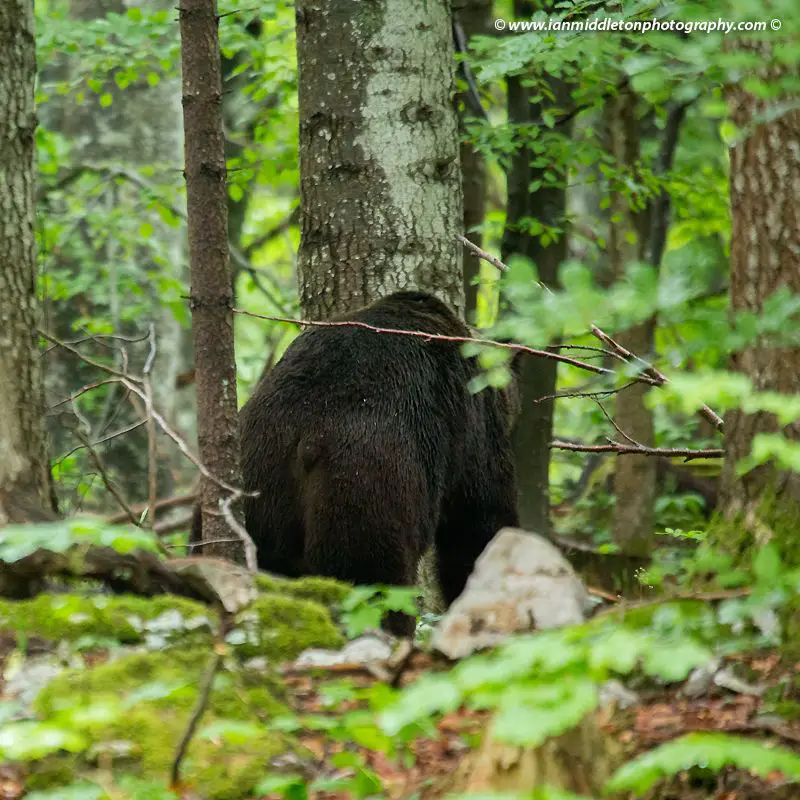
Brown Bear in the forest in Notranjska, Slovenia.
If you go down to the woods today, the likelihood that you’ll encounter a bear is extremely low. Over the years I have frequently gone driving and walking in areas where I had hoped to see or photograph them. Not a single sighting. Yet there is an estimated 800-900 European Brown Bears in Slovenia, bearing in mind (pun intended) that many of these bears and other wildlife routinely wander between Slovenia and Croatia. The brown bear is an elusive creature and at best it’s safer to go with a hunter, or an organised tour.
A few years back I did manage to find someone who had setup a series of hides specifically designed for photographers, so I was able to finally go on a bear watch and capture some great photos. However, while these are ideal for serious amateur or professional photographers, they are not so good for tourists who simply want to see the bears but don’t have the expensive camera equipment required to photograph them.
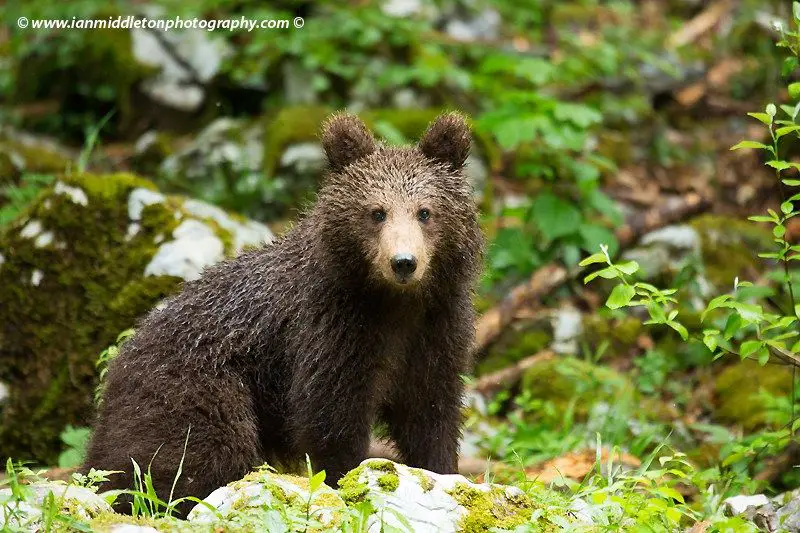
A one year old Brown Bear Cub in the forest in Notranjska, Slovenia.
So imagine my delight when I found Bears and Wildlife Tours. Based at the tourist office in the little village of Hrib, in the municipality of Loški Potok, they offer an array of wildlife watching tours as well as bear viewing huts. But the most intriguing of all, was the offer of staying the night in a simulated bear cave. I had to go and see.
The journey took me south from the capital Ljubljana to the border with Croatia, where I met with Tjaša, who organises and coordinates the tours, and Stanko, a local hunter and guide. We were already late into September so they told me that the chances of a sighting were low because the bears usually come out late in the evening, and as the sun is now setting earlier it would more than likely be dark by this time. But they would take me to see what they had to offer anyway.
Over a strong cappuccino, they told me a little about the bears and what they offer. They currently have about 7 hides in total, 3 in the Loški Potok region. This gives them much more scope to ensure a sighting for their guests. “We have never seen the same bear at each of our hides. The bears travel around 60kms per night or day. Many go from Loški Potok to Cerknica, and of course across the border,” said Tjaša.
The bears tend to travel over a specific area. A mother bear can remember from 5 years before where she got a good meal. Amazing, I struggle to remember where I ate yesterday!
Their numbers are increasing. In 1960 there was an estimated 150 bears in Slovenia. In 2018 that number was around 900. These numbers apparently swelled during the Balkan conflict; where many bears I guess fled here for asylum! I asked how it’s possible to know the numbers. “Hunters collect bear poo and send it to Ljubljana to the institute and from the DNA they can estimate their numbers. Every year the number is increasing,” replied Tjaša.
Mother bears in Slovenia are now giving birth to 3 cubs instead of 2. Rarely before have bears had more than 2. This is also an indicator that the quality of their habitat and food source is improving. 2018 was a particularly good year for food, as conditions that year made not only the forest rich with food, but the village orchards were overgrown with fruit. Stanko explained to me how September 2018 has seen an unusual rise in bears coming into the villages, much more than previous years. In autumn the bears are fattening up for the winter hibernation.
The improved quality of the habitat is partly down to conservation work, and rules being enforced that prevent hunters or bear tour organisations from feeding the bears within 2kms of a village. This helps stop them from wandering into villages in search of food and prevents any incidents with locals, and also accidents with cars. One of the biggest threats to bears is being hit by cars.
Every year the government sets an annual cull to try to control the population. For 2019 it was 200, increased from previous years because of the reasons above. However, this decision was suspended by the administrative court after a case was brought by the environmental protection organisation Alpe Adria Green (AAG).
A Winter Den and Bear Jacuzzi
After coffee we headed out for the first part of the tour. Stanko drove us to a location a few kilometres outside of town, where we stopped beside a forest road. He pointed to the forest and said that just up the hill is a winter den for a mother bear.
Bear dens are always close to water, so they can often be close to the road and village. Stanko and Tjaša then pointed to a stream running out of the forest to the roadside and told me how the bears will seek out sources of water, especially when it’s very hot.
These pools of water or streams are mostly deep in the forest well away from people and villages. However, they are also found on roadsides like this close to villages, because the water that runs off the forested hillsides collects in pools by the road. Stanko regularly comes here deer hunting and told me how, early one morning around 5am, he spotted a bear immersed in a pool of water up to its neck, with just its head poking out the surface.
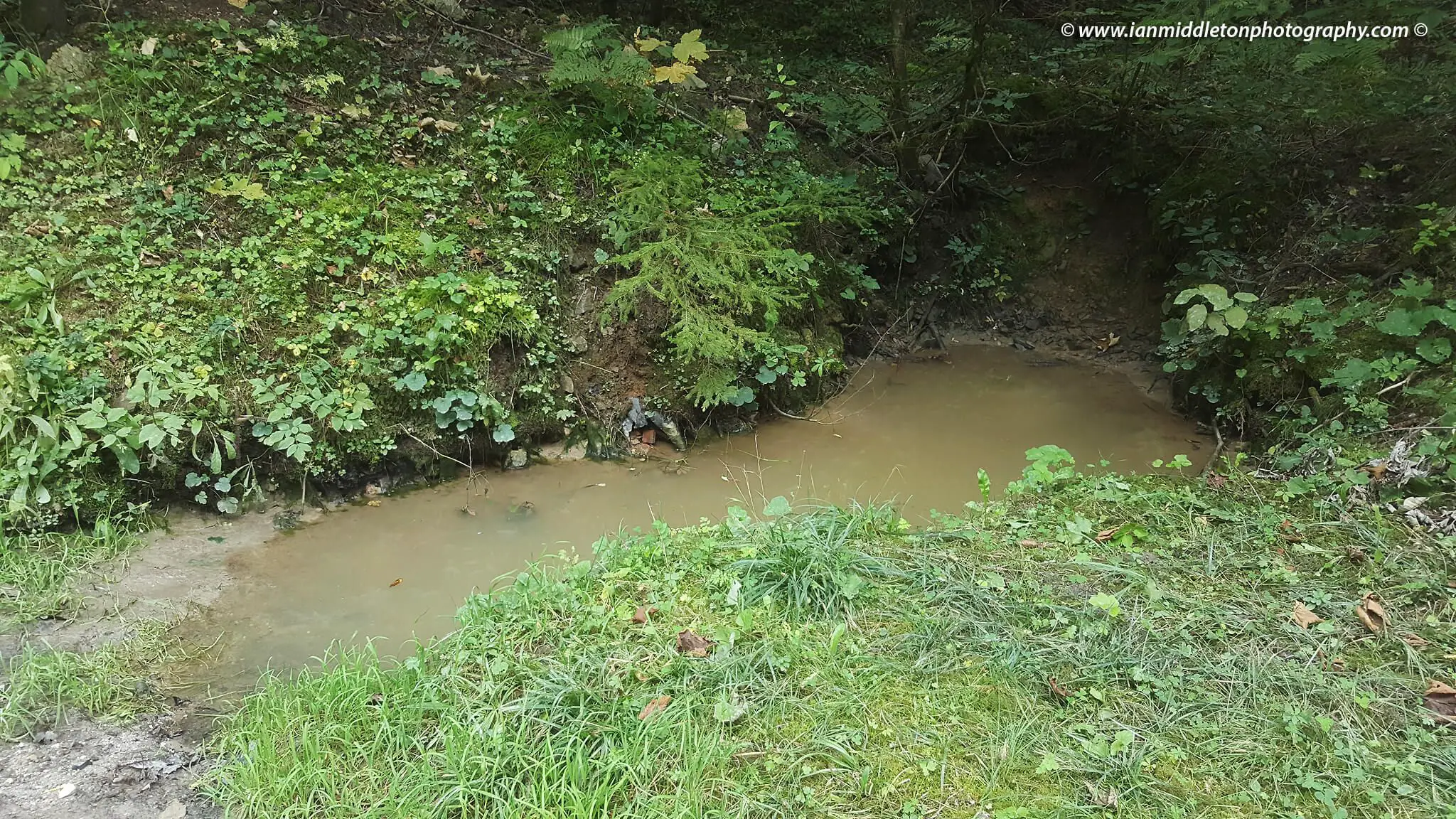
“I call it the Bear Jacuzzi”, he laughed.
The bears often come to these roadside pools to cool off in the heat of the summer days, and Stanko, and likely many locals, see them as they drive these forest roads.
Mushrooms – A national sport
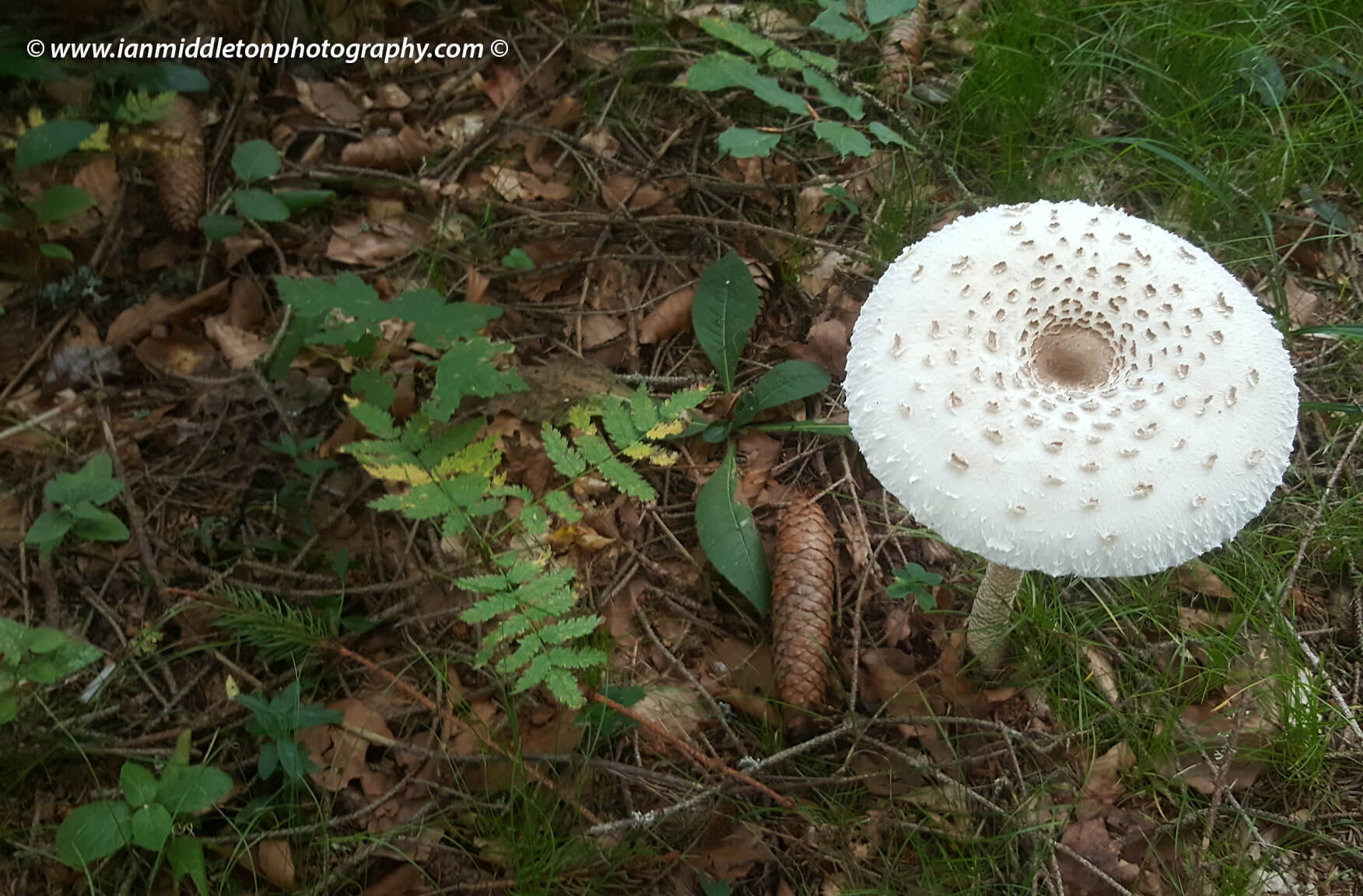
Wild Parasol mushrooms, known as Marela in Slovenia.. Macrolepiota procera or Lepiota procera
I then followed them up the hill to the winter den. On the way Tjaša picked some mushrooms and described how to prepare them. Mushroom picking, along with other forest fruits, is a national sport here in Slovenia. Every season the forests are packed with locals out mushroom picking, and they are usually racing each other to get the best and most. She also explained how to tell the difference between a poisonous and non-poisonous one.
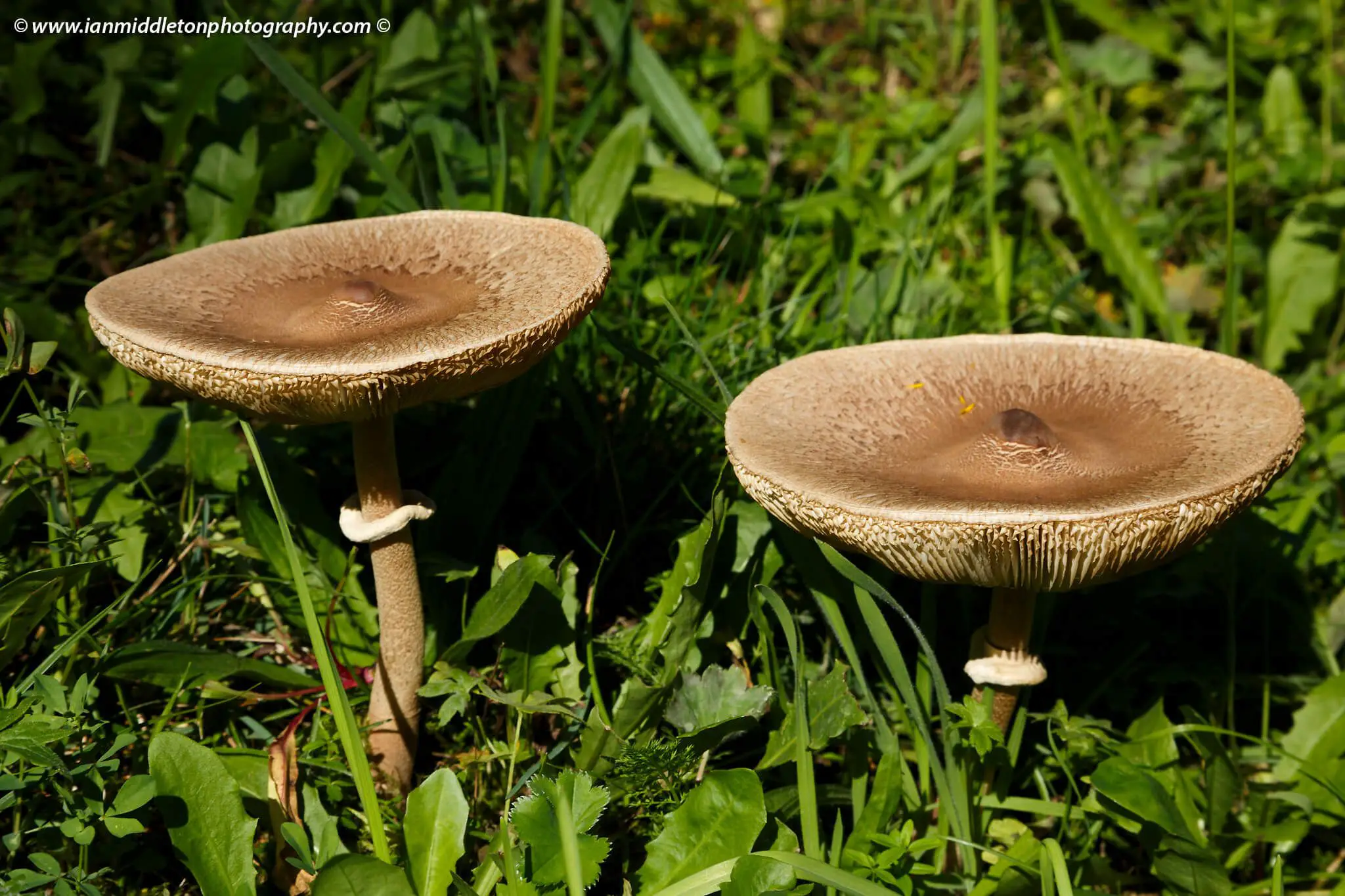
Wild Parasol mushrooms, known as Marela in Slovenia. As you can see, on the stem this circular piece is an indication that the mushroom is non-poisonous.
“I’ll take these to my mother in law’s tomorrow for cooking,” I said.
I feel I should add here that I fully intended to give my mother in law the non-poisonous mushrooms.
Slovenian folklore says that if you see a mushroom in the forest you must pick it immediately, no matter how big or small it is. Once someone has seen it, the mushroom will stop growing. Tjaša also explained that when you pick a mushroom you must clean it there and then in the forest before you take it away.
The bear cave
Bears hibernate during the winter in a den, essentially a small cave deep in a hillside. The entrance is narrow, but inside it is very wide and deep. The bear can get inside because its head and neck are very small and it doesn’t have a collar bone, so can squeeze its body through.
The bears enter the den when the first snow comes, or before if it’s a pregnant female. She will give birth in January and emerge from the den in April with her cubs. The cubs remain with the mother for two years. Therefore the bear has cubs every three years.
The male bear typically weighs 300kgs, while the female weighs 150kgs, so they can tell by the small size of the den that this is for a female only.
Responsible tourism
Bears and Wildlife Tours believe in keeping tourism to a minimum. Therefore they don’t have tours every day in the same location, so the wildlife isn’t disturbed too much. Bears can smell fresh blood from up to 4 kilometres away, and have excellent hearing too. If too many people are around the bears will hear and keep well away. Unless you are hunting!
On the way to our next destination, the viewing cave, Stanko told me a story about a time he shot a roe deer. Afterwards he placed his rifle against a tree and proceeded to cut open the deer and gut it. When he had finished pulling everything out, he took the gutted deer to his vehicle about 400 metres away.
Upon his return, Stanko got to within 100 metres to discover that between him and his rifle was a big male bear feasting on the leftover deer. It was not the most ideal of circumstances, so Stanko had no choice but to patiently wait before he could retrieve his firearm.
So to not only ensure the safety of visitors, but also ensure they don’t scare away the bears and other wildlife, they practice responsible tourism and ensure the numbers are kept low, and wildlife tours are conducted in different places each time.
There are very strict rules governing hunters and tourist organisations offering wildlife tours or trips to see bears in Slovenia. Along with the 2km rule, it is forbidden to feed the bears with farmed meat. But when gutting a deer it’s permitted to leave the leftovers in the forest for the bears to find, as long as they don’t find you first! But while an attack is undoubtedly terrible for the victim, it also means a death sentence for the bear. Once a bear has attacked a human being, it will be hunted down and killed. So these rules are not only there to protect people, but to protect the bears too.
Despite its love for meat, bears are actually 90% vegetarian. A sobering thought when you are just about to trudge through bear country.
Off to the bear viewing cave
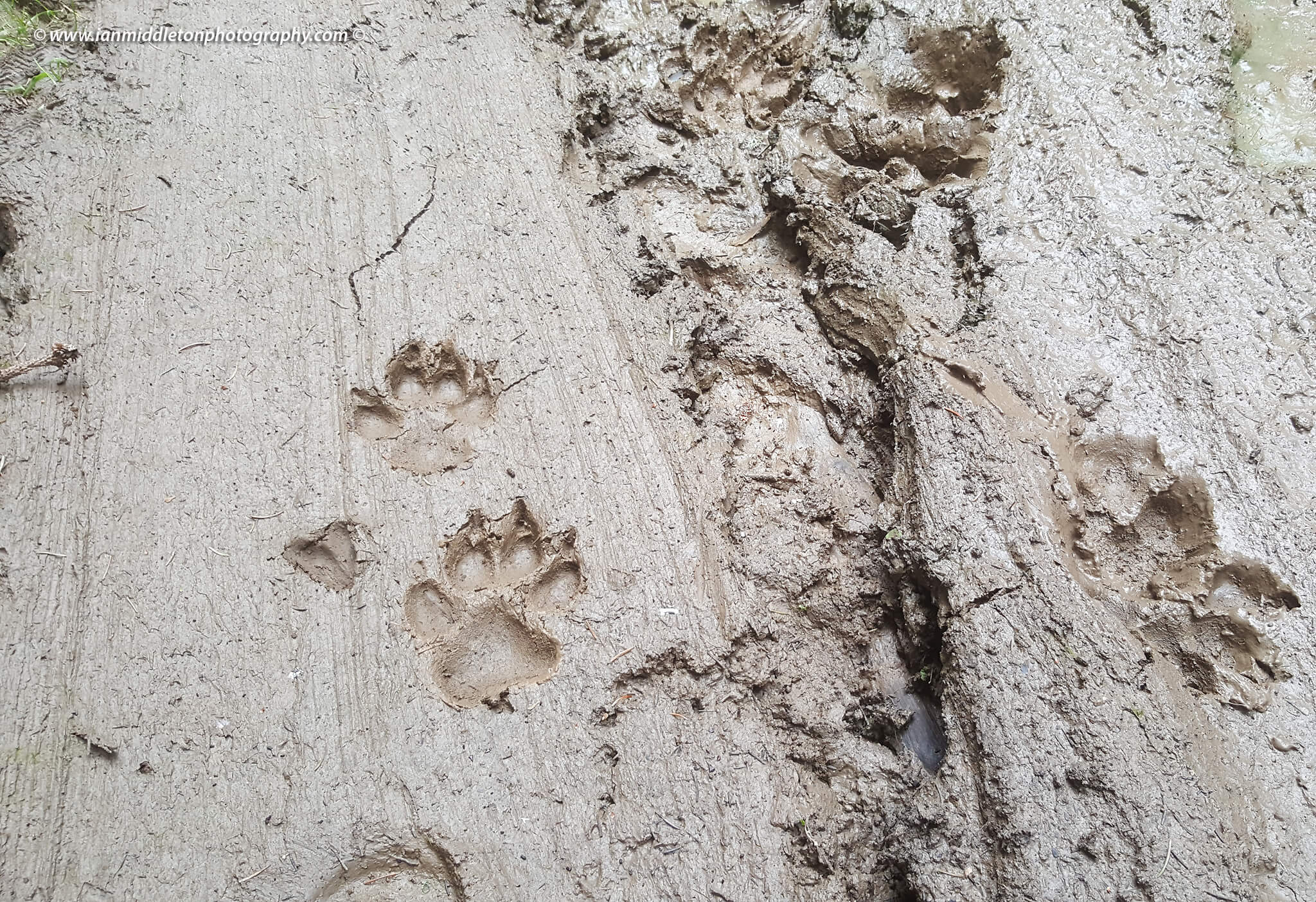
Wolf footprints in a forest in Loski Potok, Slovenia
We then headed off to the starting point of our walk deep into the forest to one of their viewing huts and, in this case, the bear viewing cave which you can sleep in. Along the way we spotted some wolf tracks, apparently attracted here because it’s deer mating season. As we got deeper into the woods I was told that from here on we must be very quiet and talk in whispers, or else the bears will sense us. In our case, we were here to spot them, so didn’t want to scare them off.
I just hoped the big bucket of apples that Tjaša was carrying wouldn’t encourage them to overcome their fear of humans!
What to do if you encounter a bear
Contrary to popular belief, bears are not the man-eating beasts they can often be portrayed as. In fact, they are very nervous creatures and will likely hear you first and keep well away. Attacks are usually the result of a bear being startled by a walker, or often a bird watcher who is not making any noise; or a photographer sneaking around to take photos. The bear will only attack if it sees no means of escape. Or if you inadvertently come between a mother and her cubs, you’re in for trouble.
Ordinarily when walking in the woods the advice is to never walk alone, and walk and talk (but don’t shout), make as much noise as possible in order to stay safe and avoid startling a bear, or other wild animal. This way the bear will hear you first.
There are many stories about what to do if you happen to surprise a bear. Although the instinct is to run, this is apparently the worst thing to do. A bear can run much faster than you, and if you run it will see you as a threat. Some say you should grab a stick and make yourself look big and loud. If the bear charges at you, remain still. Chances are it is a bluff and will veer away at the last minute.
Another crazy theory I heard is that you should run downhill, because the bear’s front legs are shorter and it cannot run fast downhill. But Tjaša laughed and said that the bear will still outrun you.
Tjaša’s advice is simple: back away slowly, always keeping your eye on the bear and it will very likely run away from you.
The Bear Cave
When we arrived at the viewing spot, a wide open meadow at the edge of the forest, Stanko went off alone first to check it was safe. Then they both prepared the food they would put out to try and attract the bears; Tjaša didn’t touch the food to ensure any human scent was kept to a minimum. For obvious reasons, the area was a short distance away from the viewing area. Tjaša explained that, for the reasons above, Stanko alone must go; no one else, not even her.
This particular viewing area is actually right beside the Croatian border. There are two places from which to observe the bears. The first is a viewing hut setup for both photographers and casual observers. The second is the specially designed bear cave. Here they have built a small wooden room into the rocks that is designed to simulate a bear’s den. Inside I was surprised to discover a cosy double bed and a row of seats next to small windows that look right out across the field to where the bears will hopefully come.
Stanko returned with a special night vision camera that they clamp to a tree where the bears are. It is triggered by movement so they can see when they are active at night. The previous night they came at 9pm, after dark. This was not looking promising for me. But as they had explained I was well into September now so the chances of a sighting during daylight were much lower.
The camera also showed a bear was here at 8.30 in the morning. So this goes to show that a night in this bear cave will undoubtedly increase your chances of a sighting. Sadly, commitments elsewhere meant I couldn’t stay the night.
The best time to take this tour is in high summer, from late May through June and July. August is also a possibility. The tours start at 16:00 and end at 22:00. There are several observation points like this, all on hills in areas of wide open space with lots of light.
But there is only one bear cave, and in this case you get to spend the night here. Naturally this increases your chances of a sighting, because you can also wake early and likely see them in the early morning.
Soon after, Tjaša and Stanko left. Just before he bolted the door, Stanko looked at me and said: “Do not go outside.”
I had no intention of doing that.
I was alone. All was quiet. I settled down for the evening, camera ready. When I had been on the photography tour a few years before we were extremely lucky that, not more than 30 minutes after settling into the observation hut, a couple of one-year old cubs came, followed by the mother and soon after a big male.
As the time ticked away I continued to live in hope. A bird of prey was swooping by occasionally, but sadly no bears.
Stanko returned to collect me after dark, and we trudged on through the forest without torches back to the car. Along the way he told me how he had been privileged to see a lynx in the forest. The Eurasian Lynx was reintroduced to Slovenia in 1973 by a hunter’s initiative. The current population is estimated at about 15-20. Thus not only are their numbers low, but they are very shy animals so a sighting is extremely rare. He showed me a photo he had. “It was a big privilege for me,” he said, proudly.
The love and respect that both Stanko and Tjaša have for the bears and other wildlife is clearly evident.
All this just goes to show how difficult it can be to spot the wildlife, and how important it is to go with an organisation like Bears and Wildlife Tours. Not only will they ensure your safety, as long as you follow their rules and instructions to the letter, but it will increase the chance that you too will be privileged enough to see one of these magnificent animals in their own habitat.
I had seen them before, but sadly not this time. However, I plan to return in May or June for another tour, and maybe even an overnight stay in a bear cave!
How to go
If you would like see bears, then visit the Bears and Wildlife Tours website. They also offer other wildlife tours, including as well as the bear cave, the opportunity to sleep on a rocky shelf in the forest and experience the sights and sounds of nature, with your guide there to keep you safe.
More info and bookings here: www.bearsandwildlife.si
Check out a video of the trip below:
For a more comprehensive look at Ian’s photography, check out his free e-book here. You can see many images in higher resolution, find other photo posts and subscribe to his newsletter here.
January 7, 2019
The administrative court suspended the implementation of the decree on the removal of brown bears from nature, which the government endorsed at the end of last November. According to the decree, 200 bears were planned to be taken out of Slovenian forests. Among these, 175 were supposed to be shot, while the remaining 25 were expected to die due to accidents or other causes.
Related: Brown bear photography in Slovenia
In December, the environmental protection organisation Alpe Adria Green (AAG) brought an action against the decree and a request for an interim injunction. The group is convinced that the decree violates the Nature Conservation Act, the Habitats Directive and the Constitution. The AAG noted that the government endorsed the decree despite numerous complaints on its drafting, and that the Ministry of Environment and Spatial Planning did not answer the requests for an explanation as to why such a number of bears had to be removed from nature. At the same time, the AAG expressed its expectation that the decree will also be annulled.
This is not the first time that the court has intervened in the destiny of large wildlife in Slovenia. The same decree that involves bears previously included eleven wolves to be taken out of nature, but after a public hearing the wolves were removed from the proposed cull. The Environmental Ministry took this decision after two judgments of the administrative court, which ruled that the reason for shooting the wolves, which was given as preventing the animals from killing livestock, and thus maintaining public acceptance of wolves, was not sufficiently substantiated.
All out stories about bears in Slovenia are here.
December 10, 2018
It has been reported last week that a Slovenian hunter killed a bear called Elisio, a collar-wearing subject of research at the University of Udine, Italy. The animal was shot in the area of Senožeče, Slovenia, and has in the past five years, while wearing the tracking collar, survived a collision with a train, completed several ascents over 2100 metres, swam across Cavazzo lake several times, and figured out how to safely cross a Slovenian highway.
The event stirred a lot of outrage on the Italian side of Elisio’s territory, while it continues to remain a minor story in Slovenia. One of the reasons might be in a conservation status of the Italian subspecies of the brown bear, that is the Apennine Brown Bear, which is marked at “critically endangered”. In contrast, the Slovenian government struggles to keep the number of ordinary European brown bears in check, with the conservation status marked as “least concern”, and bear salami being an ordinary offer at the Christmas stalls found in the central marketplace of Ljubljana. The important point here is that Elisio was an ordinary brown bear, not an endangered Apennine subspecies.
There are currently about 1,000 bears in Slovenia, and the Slovenian Ministry of Environment and Spatial Planning ordered this number to be reduced by 200, 175 of which will be taken out by hunters before April 30, 2019 (Delo). This is also the reason why Italian researchers reported weekly on Elisio's whereabouts, hoping this would prevent him from getting shot. It did not.
Andrej Sila, from Sežana branch of the Slovenia Forest Service, expressed regret at the incident: “We are all very sorry that the hunter shot Elisio. We have permission to shoot five bears in our area due to population control. It happened as a consequence of a series of unfortunate events. The hunter shot the bear in the evening, when his collar wasn't visible.”. He also explained that weekly reports on the whereabouts of the bear cannot prevent these types of accidents, since bears tend to travel tens of kilometres a day.
This is not the first time Slovenian hunters killed a bear with an Italian research collar. In 2011 a Slovenian hunter shot a bear near Vrhnika, who then turned out to be an Italian media sensation called Dino. In the preceding year Dino managed to kill 14 donkeys in Northern Italy before the Slovenian hunter did not see his collar and shot him in a forest (source). Dino’s survival prospects, however, were dim even without the shooting, as his collar had grown deep into his flesh, causing an infection and starting to slowly suffocate the animal. When the hunter first saw him, Dino was hitting his head against a tree, presumably due to the pain. The collar, unlike the ones in use today, was not equipped with a “drop-off” system, which activates when the collar becomes too small and begins making it difficult for the animal to breath.
STA, 30 November 2018 - Slovenian hunters are getting older and their organisation is struggling with declining membership, which is just one of the challenges. They also oppose culling plans that they have no say in.
The Hunters' Association (Lovske zveze Slovenije) argues that the deer culling plan imposed by the Agriculture Ministry is excessive considering the size of the deer population.
The association has told the STA their members are not in a position to realise the planned culling, but that they face high fines, from EUR 4,100 up per a hunting club, if they do not.
Hunters took 8,229 red deer and 41,869 roe deer from nature last year, which includes large numbers that perished due to extremely low winter temperatures.
Under the plan, hunters should have killed almost 5,000 red deer and 39,986 roe deer.
Despite the large numbers of deer and wild boars lost in last year's winter kill, the Hunters' Association says they have been instructed to implement the culling plan for this year in full.
"We cannot agree with a plan that doesn't take into account the projected deer population trends, but only by the damage done to trees by game."
Average age of hunters is now over 56
The Hunters' Association, counting 22,000 members, is worried about dwindling membership numbers. They have also had to withdraw more than 200 hunting licences for various reasons this year.
The average age of hunters is quite high, standing at over 56 at the end of 2017.
Membership is a key source of income for hunting clubs but an important source of income is hunting tourism although the clubs managing hunting grounds pay a concession fee to the state.
Foreign game hunters coming to Slovenia are interested mainly in chamois and bear, but they also hunt other large game.
Related: Slovenia's Ministry of Environment Wants Hunters to Kill 200 Bears and 11 Wolves
Hunting tourism is the principal activity of special-purpose hunting reserves. Out of 408 hunting reserves in the country, 12 are special purpose.
Ten of these are managed by the Slovenia Forest Service (SFS) and one by the Triglav National Park, while hunting clubs are responsible for sustainable game management.
Hunting tourism is available to guests from Slovenia and abroad. The guests who are not hunters need to be accompanied by a hunter with a valid hunter's licence.
It costs between €600 and 6,500 to kill a bear in Slovenia
Apart from domestic guests, it is Austrians, Germans and Italians who come to hunt in Slovenia most often.
Ljubljanski Vrh, one of the ten reserves managed by the SFS, hosted 1,900 guest hunters last year, some of them several times.
The Forest Service made over EUR 1m from hunting tourism last year.
The guest hunter will pay between 600 and 6,500 euro for killing a bear plus a daily hunting fee. A red deer trophy comes at between 215 and 5,500 euro and a roe deer trophy between 50 and 400 euro.
STA, 28 July 2018 - Among the many tourists that visit Slovenia every year, an increasing number decide to go bear watching. In this potentially very dangerous undertaking, visitors must be accompanied by an experienced guide, usually a hunter.
STA, 19 July 2018 - The Slovenian Ministry of the Environment and Spatial Planning has proposed culling 200 bears and 11 wolves to cope with increasing populations, inviting ire from activists.




